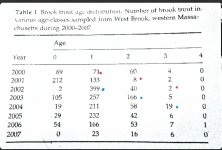Back to the topic, some visualizations based on Mike and KBob's comments.
Obviously, age 0 fish are missed in sampling. The trendline by class should be a steady decline from left to right, not a low age 0 # followed by an increase in numbers of that same cohort the following year. Unless immigration plays a role.
It's worth noting the decrease in age 3 and 4 fish may be due to emigration too. As noted in the original post, the stream is characterized as "tiny". It may not be accurate to assume the lack of older fish is due to death from harsh conditions. Maybe this is a nursery stream and the older/larger fish leave for larger habitat? Without sampling downstream or radio tagging, it's impossible to know what's happening to the older fish. It would be interesting to see sampling done across multiple seasons as well to see the rate of movement and whether, again, this is a nursery stream, rather than year-round habitat for all age classes. As is typically the case, the temporal piece of the puzzle is missing.
Here the data is organized differently from the original. Cohort tracking is diagonal as Mike mentioned. So you're following a cohort from year to year diagonally down the chart, not horizontally.
Again, the low age 0 numbers relative to the higher numbers from that same cohort the following year show how many age 0 fish are missed when sampling. i.e., cohort 2 from the graph above and in orange starting in 2001 in the spreadsheet below should have a higher count than 212 to result in 399 age 1 fish the following year, again, unless a significant portion of the age 0 fish are upstream (or down) of the sampling area and then move into the sample area when older/larger.

I'm not necessarily seeing the correlation between high age 2 fish and higher age 0 fish the following year. i.e., in 2003, the highest number of age 2 fish didn't result in a high number of age 0 fish in 2004. In fact, there were fewer age 0 fish in 2004 than there were in 2003 when the age 2 numbers were lower the prior year (2002). There was a bump in age 0 fish in 2005 and 2006 following a relatively stable or higher population of age 2 and 3 fish in 2004, but that's not an obvious occurrence in other years. Again, environmental factors may negate spawning success.

On the movement issue, I think it's important to think about the range of movement. While the Loyalsock study indicated some 20% of the population "moved", a much larger percentage moved smaller distances. Those smaller distances might still be in and out of a sample area. The biggest thing to consider is that the study was only 6 months (June - November) of the year due to transponder life, and didn't capture what happened after November when the conditions would have gotten much harsher.







